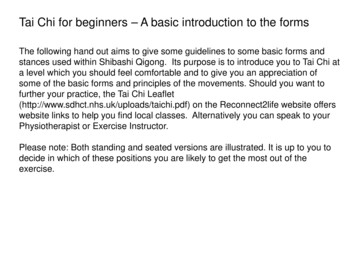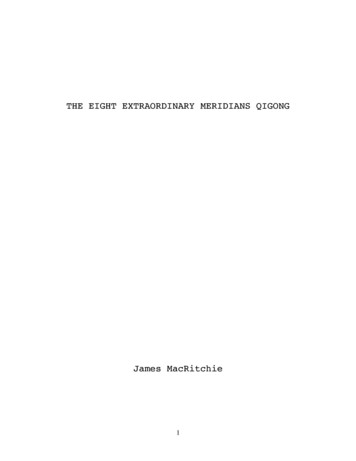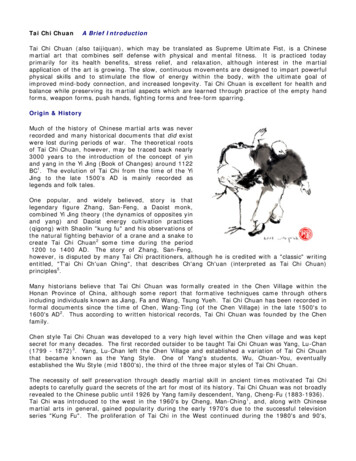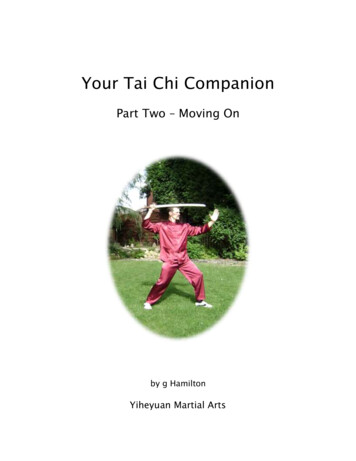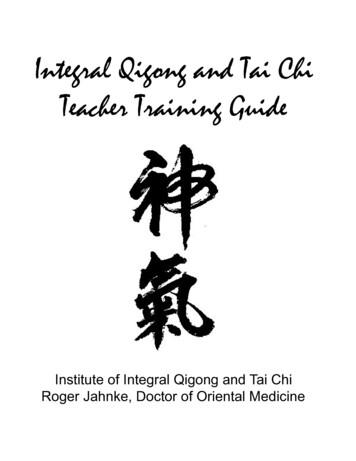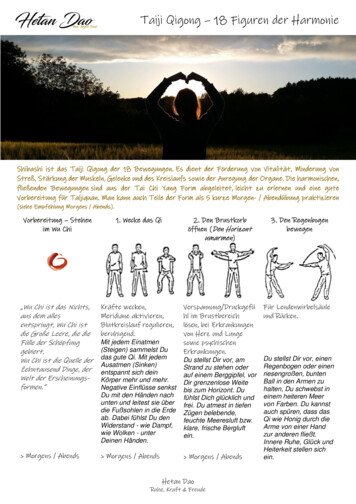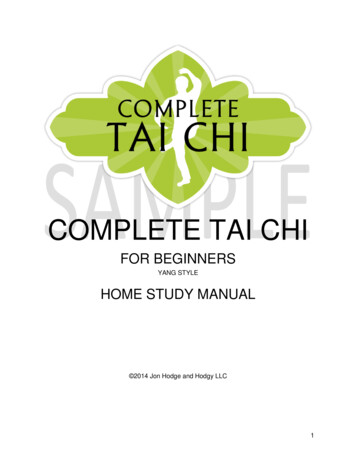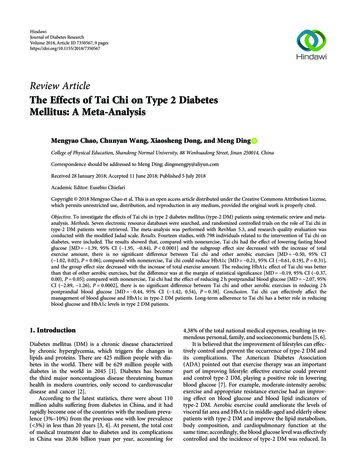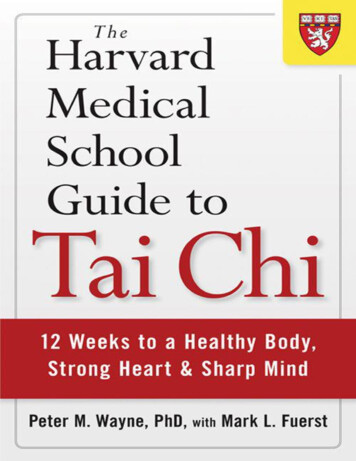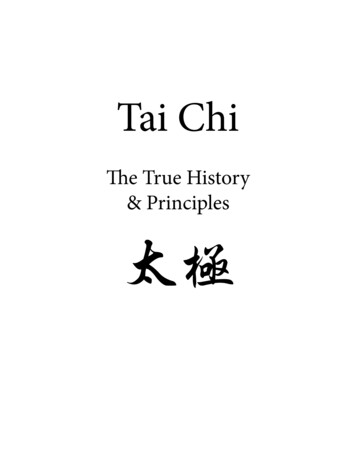
Transcription
Tai ChiThe True History& Principles太極
Tai Chi - The True History & Principles Lars Bo Christensen 2016ISBN 978-1539789314Version 1.0For contact and additional material go to:www.thetaichiworkshop.dk
ContentPreface . 1Tai Chi Literature . 3The History of Tai Chi . 5Stele Biography of Li Dao Zi.17Important Persons in Tai Chi History .21Time line of Tai Chi History.23The Tai Chi Classics of the Li Family Manual.25The Philosophy of Tai Chi.49The Traditional Methods of Training Tai Chi .61The Thirteen Movements from the Li Family manual.69Names of Chen Style Tai Chi .71Names of Yang Style Tai Chi.75Names of Wu Yuxiang Style .81Pages from the Li Family Genealogy and the Martial Arts Manual.83Illustrations and Pictures .95Overview of Old Tai Chi Texts . 125Notes . 135Literature . 145
PrefacePrefaceOver the last 100 years Tai Chi has become increasingly popular in manyparts of the world and it is practiced by both young and old. Tai Chi wascreated as a fighting system, but its unique way of strengthening the body andthe mind also makes it popular with people who have no interest in fighting.Wisdom from Daoist philosophy was blended with the best fighting techniques to create an art form that was very different from mere violence. The oldmasters had exceptional skills and this inspired other people. Tai Chi becamepopular in broader circles and many people have benefited tremendously fromthe art as it was originally created. Because of this, there should be no reason tochange the teachings of the old masters. It is, perhaps, just like Mozart, Bach orSchubert who created great classical music that lives on forever: A single notecannot be added or taken away without a decrease in the beauty of the music.A recent discovery of old texts, the Li Family Martial Arts Manual, has changedthe history of Tai Chi radically. Previously we had a few hints which indicatedthat the so-called Tai Chi classics were written by Wang Zongyue. As for thethree main styles of Tai Chi, Chen, Yang and Wu, we knew that Chen Wangting’sgreat-great-grandson, Chen Changxing, taught Yang Luchan, but we weren’t really sure who taught Wu Yuxiang and his brothers. Furthermore, we knew nothing about who taught Chen Wangting in the first place.However, we now know for certain that Tai Chi was transmitted from the Thousand Year Temple in the Henan Province. And, best of all, we have the originalprinciples of the art in the writings by members of the hitherto completely unknown Li Family. The material we already had access to wasn’t too far off themark, but now we are able to precisely determine the essence of how Tai Chishould be practiced. The names and postures may vary a bit in different styles,but there is really only one thing that can define how the movements should beperformed and that is the words of the earliest texts about the art. The old masters practiced and transmitted a truly unique martial art for building a healthybody and a serene mind and we now know, without a shadow of doubt, that thisart was based on Daoist philosophy.I want to thank Donald B. Wagner who has given much advice, and also StellaSørensen and Chi Yin Ho for correcting the manuscript.1
2PrefaceAll Chinese words, except names, are transcribed with pinyin. T’ai Chi Ch’üan isthe old Wade Giles transcription, while in Pinyin the name is written Taijiquan.However, in daily use most people know the art simply as Tai Chi, and I haveused this name throughout the book.‘Taiji’ refers to the philosophical concept which the art is based on.All translations are my own.
Tai Chi LiteratureTai Chi LiteratureTai Chi has been taught publicly for around 100 years and there exists a largeamount of literature about it. The first publications in the West were importantbecause Tai Chi was not very well known and there was a need for basic information.In fact, even in China not many people knew much about the history and originalprinciples of Tai Chi because the country had gone through a turbulent period andmuch old information was lost. Tai Chi was promoted by the Chinese governmentafter 1949, but the philosophical aspects were promoted only to a small degree. Wehave to acknowledge, though, that what made Tai Chi famous was the old masters allof whom who had wonderful skills based on philosophical principles. There are stillmasters who possess genuine knowledge but they are, unfortunately, far outnumberedby the sport-like approach that Tai Chi has turned into in many places around the world. This is why the discovery of the Li Family Manual is so very important because thewritten material from the old masters is really the only source that can truly define thenature of Tai Chi.The first written material about Tai Chi is just a handful of texts which we call the TaiChi classics and now we have the handwritten originals in the Li Family Manual, butmany other valuable texts were written later on. The classics are translated in this book,if you wish to read translations of other old texts you can find them listed with references to translations (if any) at the back of the book.Printed Literature in ChineseThe first publication of a book containing the Tai Chi classics was in 1912 when GuanBaiyi 關百益 published Taijiquan Jing 太極拳經. Xu Yusheng followed with TaijiquanShi Tujie 太極拳勢圖解 in 1921. Then came Chen Weiming’s Taijiquan Shu 太極拳術 in 1925, Xu Zhiyi’s Taijiquan Qianshuo 太極拳淺說 in 1927 and Chen Xin’s ChenShi Taijiquan Tushuo 陳氏太極拳圖說 in 1933. All were about Yang Style, exceptChen Xin’s which was about Chen Style. However, these books were far from giving acomplete picture of Tai Chi. Yang Cheng Fu and Tung Ying-Chieh published 楊澄甫Taijiquan Shiyong Fa 太極拳使用法 in 1931which provided a much more completeexplanation of the art and it included important versions of the classics. Another important book was Taijiquan Jiang Yi 太極拳講義 by Wu Gongzao 吳公藻 publishedin 1936. It consisted of 40 small, but invaluable, texts by the famous Yang Banhou. Itwas Tung Ying-Chieh who published Yang Chengfu’s book1 and he and Tian Zhaolinwere listed in the book as the two main disciples of Yang. Tian Zhaolin did not publisha book, but Tung Chieh’s book Taijiquan Shiyi 太極拳釋義 from 1948 added moreinformation and more classics. Also Yang Chengfu said himself that his postures hadimproved over the years and these are reflected in Tung Ying-Chieh’s book because helearned with Yang until his death.3
4Tai Chi LiteratureChen Yanlin’s 陳炎林 book Taijiquan Dao, Jian, Gan, Sanshou Hebian 太極拳刀, 劍,桿散手合編 also had some importance because it was based on an early version ofYang Chengfu’s book.2Tang Hao (1897-1959) wrote 19 books on martial arts and was the first to do actualscholarly research into the history of Tai Chi. His book created a useful overview of thematerial available at the time.Gu Liuxin (1908-1991) wrote five books about Tai Chi. He was a student of both YangChengfu and Chen Fake and thus knew both the Yang and Chen Styles. His books werebased on interviews and connections that very few other people had access to.Old Tai Chi books in Chinese, especially the classics, are not easy to read, not even forChinese, because they were often written in Classical Chinese. However, there havebeen several attempts at translating the most prominent Tai Chi classics and Paul Brennan has published translations of several of the oldest Tai Chi books.3Literature in EnglishThe first Tai Chi teachers came to the West in the 1960’s and already in the 70’s it gainedsome popularity. Although never as popular as yoga, Tai Chi has been well known in theWest from the 80’s. A count of the publications in English up until 2003 shows that itwas already by then beyond 300. However, there are only a few that have real valuefor defining and explaining traditional Tai Chi. 13&7*&8
The History of Tai ChiThe History of Tai ChiThe majority of the 1300 people in the Tang Village in China’s Henan Provincedescend from the Li family 李氏. In 2003 it was decided to compile a genealogyof the Li clan and the Tang Village, and Li Libing was given the task to research formaterial. Li Libing was told of an elderly man by the name Li Chenghai 李成海 whowas said to possess some material and this was true; above the door in his house wasa small room where old records of the Li family were stored. Li Chenghai was, at first,very reluctant to let anyone see his family records. The reason was that, although hewas illiterate, he knew that the genealogy recounted a story of a family member, LiYan李岩, who was a general in a rebellion army at the end of the Ming dynasty. LiYan is considered a hero today but Li Chenghai didn’t know that and saw no reasonto disclose information about a traitor in his family to anyone. However, after severalattempts Li Libing was given permission, and the bunch of worn papers was indeedinteresting. It had been stored there for 300 years and included the family genealogy,deeds and other interesting things, but the most interesting was an old martial artsmanual. This manual had dated and signed copies of the oldest existing texts on TaiChi and Li Libing realized at once the importance of the discovery.The history of Tai Chi has been the subject of a great deal of research and many bookshave been written about it. The research is clear on most points from around 1900 andon, but with regards to the origin of Tai Chi and the so-called Tai Chi classics it has beendifficult to make reliable conclusions because the available material was scarce and leftmany questions unanswered.The effort and talent of the old masters, who knew the original principles for this art,made Tai Chi famous. Hundreds of thousands of people in the West, and millions inChina, have been practicing Tai Chi for many decades and certainly will do so for a longtime to come. For this reason, it is, of course, very important to be clear about what theoriginal principles and techniques of Tai Chi really are.The Li Family Martial Arts ManualThe entire text of the Li family manual is reproduced and translated in the chapter onthe Tai Chi classics. There are texts on the philosophy, principles for internal energy aswell as names of the Tai Chi slow set, push-hands, sabre, long broadsword and lance.The texts are dated between 1590 and 1787 in the Ming dynasty. The first texts thatrelate to Tai Chi were written by Li Chunmao (1568-1666) 李春茂 over 400 years ago.The two philosophical concepts Wuji 無極 and Taiji 太極 are closely connected andone of the texts Li Chunmao wrote was called Treatise of the Health Preserving Boxing5
6The History of Tai ChiSystem of the Endless Void or 無極養生拳論—Wuji Yang Sheng Quan Lun. The textpraises the beneficial effects of the Wuji-exercises. It does not mention fighting techniques directly, but the word quan in the title 拳 means fighting, so the system musthave had fighting movements or at least a purpose related to fighting. This system, however, was not created by Li Chunmao. A rubbing of a stone tablet from the ThousandYear Temple 千载寺 was also found with the Li Family manual and it recorded that theWuji Yangsheng exercises were created in the Tang dynasty by Li Daozi 李道子 (614?). The stone tablet was called The Stele of the Biography of the Monk Ten Powers of theThousand Year Temple 千载寺唐僧十力传碑, Ten Powers was another name for LiDaozi. It was originally erected in the Thousand Year Temple and Li Daozi was a monkand abbot of the Temple in the Tang dynasty. The Thousand Year Temple was a templein the Tang Village originally built in the Eastern Han dynasty (25-220 C.E.).1 It wasa very large temple, 36 hectares, with many departments and many buildings and pavilions. It was sadly demolished in the 1950’s when spirituality became a crime, and allbuildings, libraries and more than 100 stone tablets with historical records, philosophyand poetry were destroyed.A detail of a map of the Thousand Year Temple in Tang Villagewith Taiji Hall, Taiji Gate and Eight Trigrams Gate. 13&7*&8
Stele Biography of Li Dao ZiStele Biography of Li Dao ZiThe Account of the Tang Dynasty Monk Ten Powersof the Thousand Year Temple - Author of the stele text Pu Guan.In the Great Tang Dynasty, a true Daoist came into the Li Family. His givenname was Ru Zi, his adult name Dao Wu, his assumed name Ten Powers andhis monk’s name Dao Zi. He was born in Henan North of the Yellow River onthe second day of the second moon of the tenth year of Emperor Da Ye of theSui dynasty (614).He became a disciple in Three Teachings Gate of the Henan Wuji Temple, inthe era of Shen Long, Xiang Fan, Ma Lan Cao and Mother Dan.He was talented, and studied the rich arts of literature and martial art, medicine, Yi Jing and the Nie Pan She Thesis and he was well versed in the YellowEmperor’s Classic. He brought honour to the harmonious blending of Buddhism, Daoism and Confucianism.On the basis of the Da Ming Du, the Wuji Classic, the Yijin Jing, the Dao DeJing, the Huangting Classic, the Qianjin Yifang, Daoyin and Tunei he createdWuji Yangsheng Wugong.1He studied thousand years of secret knowledge about medicine and preserving health.His martial arts abilities were extraordinary, he was given the art in a dreamand his abilities amazed the martial arts circles.An imperial edict called him to reside in the capital, and a statue of him wasbuilt on the Western Mountain.Hiding his fame under another name he transmitted the art in Dongquan,and travelled to Yangzhou to teach medicine with great clarity to able persons.He taught in Lushan and he was a role model for the Shaolin. In his later dayshe went back to educate disciples in the temple.The Master said: “The Three teachings are fair and just and they are strictrules guiding the way in martial arts practice: ‘Non-action when dealing withbad people, and only teach martial arts to help people’. Apply soft againsthard. Give up and follow people. It is not a way to get success, it is a way of nofame. The Blue Dragon raises its head, after thousand years we meet again”.Transmitting the great story of the monk Ten Powers, about his ability topreserve health with the magical powers of Liu Xun Ji Xi, Shiba Tian Ri, Jiu JiuChong Yang and Fanlao Huan Chong.17
Stele Biography of Li Dao Zi19
Important Persons in Tai Chi History21
Time line of Tai Chi HistoryTime line of Tai Chi History67 C.E.The Thousand Year Temple was built in the Eastern Han dynasty.Ca. 650Li Dao Zi creates Wuji Yangsheng Quan Gong (assuming he was 45).1716Pu Guan writes the stele about Li Dao Zi.1590Li Chunmao writes Wuji Yangsheng Quan Lun.Ca. 1630Li Zhong, Li Xin and Chen Wangting becomes disciples in the Temple.Ca. 1650Li Zhong writes Xinggong Xinfa Bian (assuming he was 50 years old).1787Li Helin writes Dashou Ge and Taijiquan Lun.Ca. 1810-20 Yang Lu Chan studies martial arts with Wang Chang (assuming he was 10-20).Ca. 1820-30 Yang Lu Chan studies with Chen Chang Xing (assuming he was 20-30).Ca. 1840-Yang Lu Chan begins to teach Tai Chi in Beijing (assuming he was 40).Ca. 1840Wu Ruqing obtains the classics in the salt store (assuming he was 50).Ca. 1875Yang Banhou writes the “40 chapters” (assuming he was 40).1912Beijing Physical Culture Research Society is founded.1912Yang Chengfu starts to teach in Beijing.1921Xu Longhou writes the first published book on Tai Chi (Yang Style).1925Chen Weiming writes the book with Yang Chengfu’s first set of pictures.1931Tung Ying Chieh writes the book with Yang Chengfu’s second set of pictures.1930-33Tang Hao research all available material on Tai Chi.1933Chen Xin writes the first book on Chen Style.23
The Tai Chi Classics of the Li Family ManualThe Tai Chi Classicsof the Li Family ManualThere exist a number of older texts with relation to Tai Chi and the oldest are usually called the Tai Chi classics. However, this subject is not so simple because there exist many other old texts with connection to famous Tai Chi masters. Furthermore,the texts exist in different versions and have been ascribed to different authors. Theoldest Styles, the Chen family Style, Yang family Style and Wu family Style each havetheir own distinct ways of executing movements and energy even though the posturesoften have similar names. The common theme is that they imitate the principles of thetaiji symbol and that the movements are slow and continuous. In push hands practiceand fighting application, there should never be hard against hard and sensitivity andflexibility before issuing power is the main principle when engaging with a partner.These few common principles can be found in many of the old texts, and therefore theyare important to us. But, of course, it is the Li Family texts that are the most importantbecause they are the oldest. They are genuine and very nearly flawless. Best of all is thatthe authors and dates are given for most of them.The Li Family Martial Arts Manual is very close to the texts handed down in the Yangand Wu families. There has been much research into the authenticity of the Li FamilyManual and the conclusion seems to be that it is not a forgery. There are still unanswered questions, but there can be no doubt that the Li Family manual is the oldestversion of the classics. However, it is quite clear that martial arts were widespread inboth the Ming and Qing period and we must not forget that there can be other old textsand systems that have had influence on these texts.This book will mostly cover the oldest known versions of the classics in the Li FamilyManual and, to this end, I have translated the entire manual.If you want to compare the Li Family texts with the Yang and Wu versions found inmany other Tai Chi books I have prepared an overview in a separate chapter that includes many old Tai Chi related texts.25
26The Tai Chi Classics of the Li Family ManualThe Li Family Martial Arts �無極養生功者, 人未練之先, 無思無意, 無形無象, 無我無他,胸中混混沌沌, 一氣渾論, 無所向意者也, 世人不知有逆運之理, 但斤斤於天地自然順行之道, 氣拘物蔽, 昏昧不明,以致體質虛弱, 陽極必陰, 陰極必亡, 於此攝生之術, 概乎未有諳也。惟三教融易, 聖人獨能滲透逆運之術, 攬陰陽、奪造化、轉乾坤、扭氣機, 於後天中返先天。復出歸元, 保合太和, �伸縮之道, �感之無極養生功乃人之無意無形, 聯先天極妙之主體, 沖和之本始, �, 人之真元所從而來, 靈明所從而抱, �, 通則變, �之天年, 暢達人之血脈筋骨, 欲從後天返先天, �目元遠矣, 無極養生功有百益而無一害, 雖以之強吾氏族也, ��室祠傳拳訓論李葉蓁
The Tai Chi Classics of the Li Family ManualTreatise of the Health Preserving Boxing System ofthe Endless VoidBefore people start practicing the Wuji Yangsheng Gong they have nothought and no intention, no form or shape, no sense of self or others.The mind is utter confusion, all is but muddled ideas and the mind has nodirection.Common people do not know that there is a reason for unlucky fate, theymerely witness Dao running its natural course in everything.Their qi is limited, their material circumstances are shabby and they aredim and ignorant.The result is a weak constitution and poor health.Extreme yang must be [balanced towards] yin, extreme yin must be gotten rid of. In this art of conserving one’s health how could we not be wellaware of this?Only the doctrine of The Three Teachings blend and exchange [the bestfrom each school], only the wise person can decipher the mechanisms ofbad luck.Embrace yin and yang. Strive to create good fortune.Interchange Qian and Kun. Turn the qi so it changes from After Heavenand returns to Before Heaven. Come back to the origin and keep the unity of the Great Harmony.After all, was there ever anything but the Heavenly principles of AfterHeaven, the Five Phases and the Eight Trigrams?That the Way is at one time expanding and contracting is the same aswhen we say Wuji Gong can create complete qi.We do the Wuji Yangsheng exercises to explore the sentiments so people’slack of intention and form can connect to the larger perspective of thegreat wonders of Before Heaven which is the original beginning of thedual harmony — the very start of yin-yang movement and stillness.The creation of all things bears yin and holds yang, humanity’s true originthus comes from this.When the spirit is clear it can grasp ’Wuji creates Taiji’. In this there arealso the Five Phases and the Eight Trigrams which are the very first thatcomes through [from Wuji to Taiji], [after] they have come through then27
28The Tai Chi Classics of the Li Family Manualthey change to become the yin-yang of the complete body and keep themind high-spirited.It perpetuates the lifespan of men and it cleanses the blood vessels, fleshand bones.If we want to shift from After Heaven to Before Heaven then [use] this artof health, the Wuji Yangsheng Exercises.If you carelessly apply false methods, the purpose will be far from theoriginal.Wuji Yangsheng Gong has 100 benefits but not a single harmful effect. SoI employ it to strengthen my clan. We can now say that many devoted disciples of our fine clan have trained this great exercise [and have come] far.Therefore, I sincerely present this treatise of the Health Preserving Exercises of the Endless Void.The second spring moon of the Geng Yin year (1590) in the reign ofGreat Ming Dynasty Emperor Wan Li. Instructional treatise first timepresented in the Great Hall of the Ancestral Temple.Li Yezhen (Li Chunmao)
The Tai Chi Classics of the Li Family Manual十三勢行功歌十三總勢莫輕視, 命意源頭在腰隙。變轉虛實須留意, 氣遍身軀不少滯。靜中獨動動猶靜, 因敵變化是神奇。勢勢存心揆用意, 得來不覺費工夫。刻刻留意在腰間, 腹內鬆靜氣騰然。尾閭中正神貫頂, 滿身輕利頂頭懸。仔細留心向推求, 屈伸開合聽自由。入門引路須口授, 工夫無息法自修。若言體用何為準, 意氣君來骨肉臣。想推用意終何在, 益壽延年不老春。歌兮歌兮百四十, 字字真切已無遺。若不向此推求去, ��Poem on the practice of the Thirteen MovementsThe set of the thirteen movements should not be taken lightlyThe fountain from where its purpose well, is in the waist.Carefully pay attention to the shifts and turns of empty and full,Qi must be in the entire body without the slightest deficiency.In stillness on your own moving like you were still,but the opponent shifts and vary so this is a marvel.Each and every move has design and purpose,but it will not come without consciously spending time and effort.In every moment keep your mind on the waist,Be relaxed and quiet in the abdomen, then the qi will rise.Hold the lower regions centred and straight, then the spirit passesthrough to the top of the head.The whole body light and sharp, holding the head as suspended fromabove.29
30The Tai Chi Classics of the Li Family ManualGive full awareness to that which you want to learn.Bend, extend, open and close should be natural.Go through the gate and seek guidance, the teaching must be word ofmouth. Exert yourself ceaselessly and study the method on your own.If you ask what the principle for the body is,the intention and qi is the ruler, bones and flesh are the subjects.If wondering about the final purpose, it is to prolong life and stay youthful.This is my poem of one hundred and forty characters,word by word clear and distinct, nothing omitted.If proceeding without heeding these words you will waste your effort andhave cause for sighing.The second spring moon of the Geng Yin year (1590) in the reign ofGreat Ming Dynasty Emperor Wan Li. Instructional poem on the thirteen boxing movements. First time presented in the Great Hall of theAncestral Temple.Li Chunmao (Li Yezhen) 13&7*&8
The Philosophy of Tai ChiThe Philosophy of Tai ChiThe Tai Chi classics talk about circles, yin and yang, Taiji and about the thirteenbasic moves which corresponds to the five phases and the eight trigrams. To knowwhere these concepts arose from, we have to go far back in China’s history. Readingthe Tai Chi classics, it is obvious that Tai Chi’s textual tradition has been inspired byNeo-Confucianism. But certainly also by ancient Daoist classics like the Dao De Jing.Besides the concept of The Way (Dao or Tao), both traditions have at their core anarrative of the creation of the world — how everything came from a single commoncore that evolved into everything under the sky through myriads of transformations.This can be understood as a cosmological explanation of the universe, but it can alsobe seen as the internal rise and transformation of the life force of human beings.An explanation of Taiji 太極The Taiji symbol 太極圖, sometimes called the “Double fish symbol”, is without doubtthe most well-known symbol from Chinese philosophy. In both China and the rest ofthe world it is known as the symbol of the duality of all things. In the West it is often mistakenly known as the Yin-Yang Symbol. Duality is found in every aspect of life:There cannot exist dark without light, soft without hard, male without female and so onand so forth because nothing can be defined without a contrast.The origin of the diagram is unknown and there exists no original explanation of it.Most people associate it with yin and yang, but that is only a part of the explanationbecause there are also the two dots and the circle itself.Everyone agrees that the two “fish” are the dualities yin and yang, but it is much harderto find an explanation of the two dots and the circle. I find it logical to assume that “theeye” is a tiny new seed that appears from nothing and becomes the one side of a newTaiji where the duality is between the dot and the fish which together form a new Taiji.Now the symbol can be divided into two independent Taiji symbols which again can befurther divided indefinitely. This fits well with the traditional Chinese cosmology whereeverything under the sky is coming from one source and still carrying the original dual-49
64The Traditional Methods of Training Tai ChiDrawing of Lan Za Yi or Lan Que Wei from the Xinyimanual (left) and from Qi Jiguang’s manual (right).In Tai Chi the name Needle to the Sea Bottom is written the same way everywhere.However, in the Xinyi Boxing manual, the name is written with four characters 海底撈針, which means finding a needle in the ocean. This could likely be an older versionbecause this expression is quite common in Chinese. It is the equivalent to finding aneedle in a haystack.There exist several other name lists for sets of other kinds of martial arts training movements in the area around the Tang Village. They are far from being identical, but it isinteresting that they have many names in common with both the Chen Style and the LiFamily Manual.7 This proves only that martial arts were wide spread in the area and thatpeople were altering and creating moves themselves. An attempt to sort the names outwould be fruitless because, in fact, we simply don’t have any further documentation thatcan help us determine which names are the oldest.The name 抱虎歸山 Carry Tiger and Return to the Mountain, which is common today,is written 豹虎推山 in the Li Family manual and means Leopard and Tiger Push theMountain. However, 虎豹 are reversed in the version from Yigou Village 义沟村 andthis would be meaningless with 抱虎8. In other words, no one would reverse 抱虎 andthis means that it is highly likely that 豹虎推山 is the original name.The name Gao Tan Ma 高探馬 means Mounted Scout. It is nearly always translated HighPat on Horse or Pat High Horse because the hand movement could resemble patting ahigh horse, but this is not correct. Hanyu Da Cidian gives the difinition for tanma 探馬as Mounted Scout. 高探馬 means High Mounted Scout which can mean that the scoutis 13&7*&8
The Thirteen Movements from the Li Family manualThe Thirteen Movementsfrom the Li Family ting postureGrasp Sparrow’s tailSingle WhipLift HandsWhite Crane Shows its WingsBrush Knee in a Crossed StancePlay the PipaBrush Knee in a Crossed StancePlay the PipaStep Forward Deflect Block and PunchSealing OffLeopard and Tiger Pushing the MountainGrasp Sparrow’s tailBeware the Fist Under ElbowRepulse the MonkeySlanted FlyingWhite Crane Shows its WingsBrush Knee and Bend LegNeedle to the Sea BottomFan Open from BackSingle WhipGrasp Sparrow’s tailCloud HandsHigh Mounted ScoutLift the Foot left and RightTurn the Body and KickStep Forward and Punch DownTurn Around and Double KickPunch the Body and KickTurn the Body and KickStep Forward Deflect Block and PunchSealing OffLeopard and Tiger Pushing the MountainDiagonal Single WhipWild Horse Parts its ManeSingle Whip 13&7*&8 69
Names of Wu Yuxiang StyleNames of Wu Yuxiang StyleThe oldest available source is Hao He - Wang Zongyue Taijiquan Lun 郝和 - 王宗岳太極拳論懶扎衣 Lazily Tying Clothes單鞭 Single Whip提手上勢 Lift Hands白鵝亮翅 White Crane Shows Its Wings摟膝拗步 Brush Knee Crossed Stance手揮琵琶勢 Play The Pipa摟膝拗步 Brush Knee Crossed Stance手揮琵琶勢 Play The Pipa上步搬攬捶 Step Forward, Deflect, Block and Punch如封似閉 Sealing Off抱虎推山 Carry the Tiger and return to Mountain單鞭 Single Whip肘
the Tai Chi classics. !ere are texts on the philosophy, principles for internal energy as well as names of the Tai Chi slow set, push-hands, sabre, long broadsword and lance. !e texts are dated between 1590 and 1787 in the Ming dynasty. !e 'rst texts that relate to Tai Chi were wri)en by Li Chunmao (1568-1666) 李春茂 over 400 years ago.
